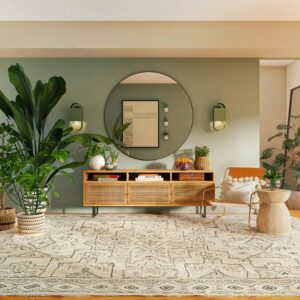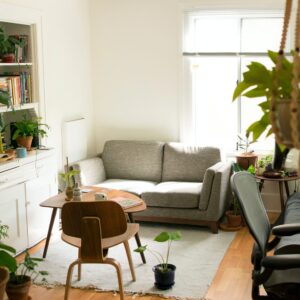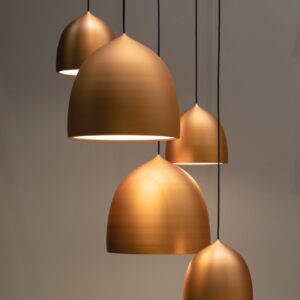“Sustainable materials in interior design for eco-conscious homes”
A Greener Palette: Navigating Sustainable Materials in Interior Design for Eco-Conscious Homes
In an era where environmental consciousness is no longer a trend but a necessity, the choices we make in designing our living spaces hold a profound impact. Our homes, the sanctuaries where we seek comfort and solace, can become beacons of sustainability through thoughtful interior design. Join me as we explore the realm of sustainable materials, discovering how they not only lend aesthetic charm to our spaces but also contribute to a healthier planet.
Table of Contents
Toggle1. Reclaimed Wood: Crafting Stories, Preserving Forests
Embarking on our sustainable design journey, let’s first bask in the warmth and character of reclaimed wood. Salvaged from old barns, warehouses, or even ships, reclaimed wood not only narrates tales of the past but also reduces the demand for fresh timber. From sturdy flooring to artisan-crafted furniture, every piece becomes a unique echo of history.
2. Bamboo: Nature’s Rapidly Renewable Marvel
Often hailed as the “green steel” of the plant kingdom, bamboo stands tall as a paragon of sustainability. With its rapid growth and minimal need for pesticides, bamboo serves as an eco-friendly alternative in flooring, furniture, and even textiles. Choosing bamboo is not just a design decision; it’s a commitment to preserving our forests.
3. Recycled Metal: Industrial Chic with a Conscience
Unveil the allure of industrial chic with recycled metals, where discarded materials find new life as captivating fixtures and furnishings. Aluminum, steel, copper, and brass, once destined for scrap yards, now grace our living spaces. Choosing recycled metals is an ode to durability, creativity, and the circular economy.
4. Cork: Nature’s Resilient Gift
Harvested from the bark of cork oak trees, cork emerges as a sustainable material that beautifully marries form and function. Used in flooring, wall coverings, and even furniture, cork exudes a natural warmth and resilience. Choosing cork is not just a design preference; it’s a nod to the importance of sustainable forestry practices.
5. Recycled Glass: Shimmering Elegance with a Second Act
Illuminate your space with the sparkling allure of recycled glass, where discarded bottles and windows transform into exquisite countertops, tiles, and decorative accents. Beyond its aesthetic appeal, choosing recycled glass is a commitment to waste reduction and a testament to the transformative power of sustainable design.
6. Hemp Fabrics: Sustainable Softness Underfoot
Textiles weave stories of comfort and style, and hemp fabrics emerge as a sustainable choice with minimal environmental impact. Hemp requires less water and pesticides to grow, offering strong and durable fibers perfect for upholstery, curtains, and bedding. Embracing hemp is not just a design preference; it’s a conscious step towards sustainable living.
7. Upcycled Furniture: Breathing New Life into Forgotten Pieces
Championing the charm of upcycled furniture, where discarded or vintage pieces undergo a metamorphosis into unique treasures. From repainted dressers to creatively refurbished chairs, upcycled furniture not only reduces the demand for new materials but also embodies the beauty of giving old things a new story.
8. Recycled Plastic: Transforming Pollution into Possibilities
Combatting plastic pollution takes center stage with recycled plastic materials finding a home in interior design. From furniture to rugs and decorative accessories, recycled plastic showcases the potential of repurposing. Choosing recycled plastic is not just a design decision; it’s a tangible effort towards a circular economy.
9. Natural Stone: Earth’s Timeless Elegance, Responsibly Sourced
While stone has been a classic choice in interior design, opting for locally sourced and responsibly quarried natural stone enhances its sustainability. Limestone, soapstone, and other stones bring an earthy elegance to our homes while minimizing environmental impact. Choosing natural stone is not just a design choice; it’s a commitment to responsible resourcing.
10. Low VOC Paints: Brushing with Healthier Hues
Concluding our journey with a stroke of color, low VOC (volatile organic compound) paints emerge as a healthier alternative. Emitting fewer harmful chemicals, these paints contribute to better indoor air quality. Beyond their aesthetic appeal, choosing low VOC paints is a nod to the well-being of our living spaces and the planet.
In Conclusion: Shaping Sustainable Sanctuaries
As we weave sustainability into the fabric of our homes, these choices in sustainable materials are more than just design preferences—they are conscious steps towards shaping a better world. Our living spaces become not only reflections of personal taste and style but also testaments to our commitment to preserving the beauty of our planet. Let us continue to craft sustainable sanctuaries, where every element is a brushstroke in a canvas of conscious living.

















